Sharp PN-K321 32-Inch Ultra HD Monitor Review: More 4K!
Why you can trust Tom's Hardware
Packaging, Physical Layout And Accessories
We received our press sample in a road case rather than its normal carton, so we can’t comment on packaging quality. The monitor is quite heavy; we can only hope that Sharp provides sufficient protection for it. Any mail-order product you buy at this price should be thoroughly checked for damage, regardless.
The accessory bundle is minimal and consists only of a DisplayPort cable and a dongle to convert a 9-pin RS-232 connector to the mini-headphone type used by the PN-K321. It’s designed for control purposes. You also get a CD containing the user manual and drivers. A printed setup guide is included, along with a stick-on control key label for the bezel. An external power brick takes care of the electrical requirements.
Product 360
Weighing almost 30 pounds and measuring nearly 30 inches wide, the PN-K321 is quite substantial in both size and mass. The anti-glare layer is light like all of the Ultra HD screens we’ve worked with. This mitigates any impact on image clarity. Given such small pixels, an aggressive front layer would destroy detail. In all our tests, both benchmarks and in use, we observed a sharp image free of visible grain or other degradations.
The bezel is one inch all around and, along with the rest of the chassis, is finished in a matte black plastic that feels very solid. Medium silver trim is found on the panel’s top and bottom edges, and on the upright. The base is fairly large. Expect it to consume about one square foot of desktop space.
There is a full range of ergonomic adjustments available. You get 5½ inches of height plus the usual 25 degrees tilt and 90 degrees swivel. There is a portrait mode, but you have to reattach the stand to use it. You can’t simply rotate the panel.
For such a heavy monitor, the side profile is surprisingly thin at less than two inches. In the photo, you can see the control buttons that aren't visible from the front. They must be operated by feel, although Sharp provides a stick-on label for the bezel. The buttons require firm pressure to operate, and we found them less than intuitive for navigating the old-school-looking OSD.
There is more than enough ventilation around back. You can also see the two connection panels. The power brick connects to the left side and there’s a toggle switch to shut down power completely. On the right are the video, audio and control inputs. Sharp provides stick-on cable clips to keep things neat and tidy. VESA bracket mounts are provided at both 100 and 200mm sizes.
Get Tom's Hardware's best news and in-depth reviews, straight to your inbox.
The inputs face sideways; they're very easy to see and reach. At the top is an RS-232 jack (adapter included) followed by two HDMI and one DisplayPort input. Last is a 3.5mm stereo audio jack driving the internal two-watt speakers. Like most monitors, they sound weak and tinny. The audio signal can come from either an HDMI- or DisplayPort-attached source device. Unfortunately, there is no headphone output or USB hub.
Current page: Packaging, Physical Layout And Accessories
Prev Page Sharp PN-K321 32-Inch Ultra HD Monitor Review Next Page OSD Setup And Calibration Of The Sharp PN-K321
Christian Eberle is a Contributing Editor for Tom's Hardware US. He's a veteran reviewer of A/V equipment, specializing in monitors. Christian began his obsession with tech when he built his first PC in 1991, a 286 running DOS 3.0 at a blazing 12MHz. In 2006, he undertook training from the Imaging Science Foundation in video calibration and testing and thus started a passion for precise imaging that persists to this day. He is also a professional musician with a degree from the New England Conservatory as a classical bassoonist which he used to good effect as a performer with the West Point Army Band from 1987 to 2013. He enjoys watching movies and listening to high-end audio in his custom-built home theater and can be seen riding trails near his home on a race-ready ICE VTX recumbent trike. Christian enjoys the endless summer in Florida where he lives with his wife and Chihuahua and plays with orchestras around the state.
-
10tacle I'd start *thinking* about buying one of these at a $1500 price point, get more serious at a $1200 price point, and pull the trigger at a $1000 price point...AND when it's a 120Hz panel.Reply -
InvalidError Reply
Give it some time. Display manufacturers like gouging fat wallets while they can to recover some of their R&D costs while production volumes are still low and their products are still different enough to justify higher margins over models aiming for the bargain basement.14481231 said:Over $3000
NEXT
Get this BS under $1000 or dont even release it. -
loki1944 Maybe by the time single GPUs can run games at 60fps on 4K prices will be reasonable, because right now holy cow. Sticking with my 1080p and 1440p monitors for now.Reply -
NightshadeRC I got 2 of the Samsung 4k 60hz monitors about 3 months ago and they were only $349 each. Much better than the 1080p for $150-$200 and 1440p was another couple of hundred more (in Australia, tech tends to cost a bit more).Reply
It's won't be long before 4k TN gets more popular -
jfkeenan Cost is one thing, but why aren't they using HDMI 2.0? My GTX 980 is begging for a 4K 60hz monitor.Reply -
rantoc Got an Dell 3214 and the "split screen" (many don't know this fact about the current 4k 1.2 DP driven displays running at 60hz but in order for DP1.2 to show 4k @ 60 hz the screen is virtually split into two screens over the interface and then combined) issue, many have all kind problems with this including only picture on one screen, different resolutions on one half or all kind of wake from sleep issues.Reply
My advice - Wait for DP1.3 that can handle 4k@60hz properly before considering an 4k screen and that is a shame - the resolution and picture clarity on the Dell UP3214Q is an enormous breakthrough - The issues however are so severe i'm not even using it! So much for a 2000$ monitor =/



